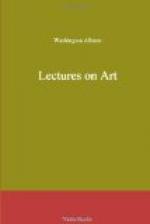Nor can the truth they present be ascribed to the technic process, which we have supposed the same with each; as, on such a supposition, with their equal skill, the result must have been identical. No; by whatever it is that one man’s mental impression, or his mode of thought, is made to differ from another’s, it is that something, which our imaginary artists have here transferred to their pencil, that makes them different, yet both original.
Now, whether the medium through which the impressions, conceptions, or emotions of the mind are thus externally realized be that of colors, words, or any thing else, this mysterious though certain principle is, as we believe, the true and only source of all originality.
In the power of assimilating what is foreign, or external, to our own particular nature consists the individualizing law, and in the power of reproducing what is thus modified consists the originating cause.
Let us turn now to an opposite example,—to a mere mechanical copy of some natural object, where the marks in question are wholly wanting. Will any one be truly affected by it? We think not; we do not say that he will not praise it,—this he may do from various motives; but his feeling—if we may so name the index of the law within—will not be called forth to any spontaneous correspondence with the object before him.
But why talk of feeling, says the pseudo-connoisseur, where we should only, or at least first, bring knowledge? This is the common cant of those who become critics for the sake of distinction. Let the Artist avoid them, if he would not disfranchise himself in the suppression of that uncompromising test within him, which is the only sure guide to the truth without.
It is a poor ambition to desire the office of a judge merely for the sake of passing sentence. But such an ambition is not likely to possess a person of true sensibility. There are some, however, in whom there is no deficiency of sensibility, yet who, either from self-distrust, or from some mistaken notion of Art, are easily persuaded to give up a right feeling, in exchange for what they may suppose to be knowledge,—the barren knowledge of faults; as if there could be a human production without them! Nevertheless, there is little to be apprehended from any conventional theory, by one who is forewarned of its mere negative power,—that it can, at best, only suppress feeling; for no one ever was, or ever can be, argued into a real liking for what he has once felt to be false. But, where the feeling is genuine, and not the mere reflex of a popular notion, so far as it goes it must be true. Let no one, therefore, distrust it, to take counsel of his head, when he finds himself standing before a work of Art. Does he feel its truth? is the only question,—if, indeed, the impertinence of the understanding should then propound one; which we think it will not, where the feeling is powerful. To such a one, the characteristic of Art upon which we are now discoursing will force its way with the power of light; nor will he ever be in danger of mistaking a mechanical copy for a living imitation.




